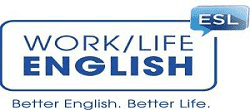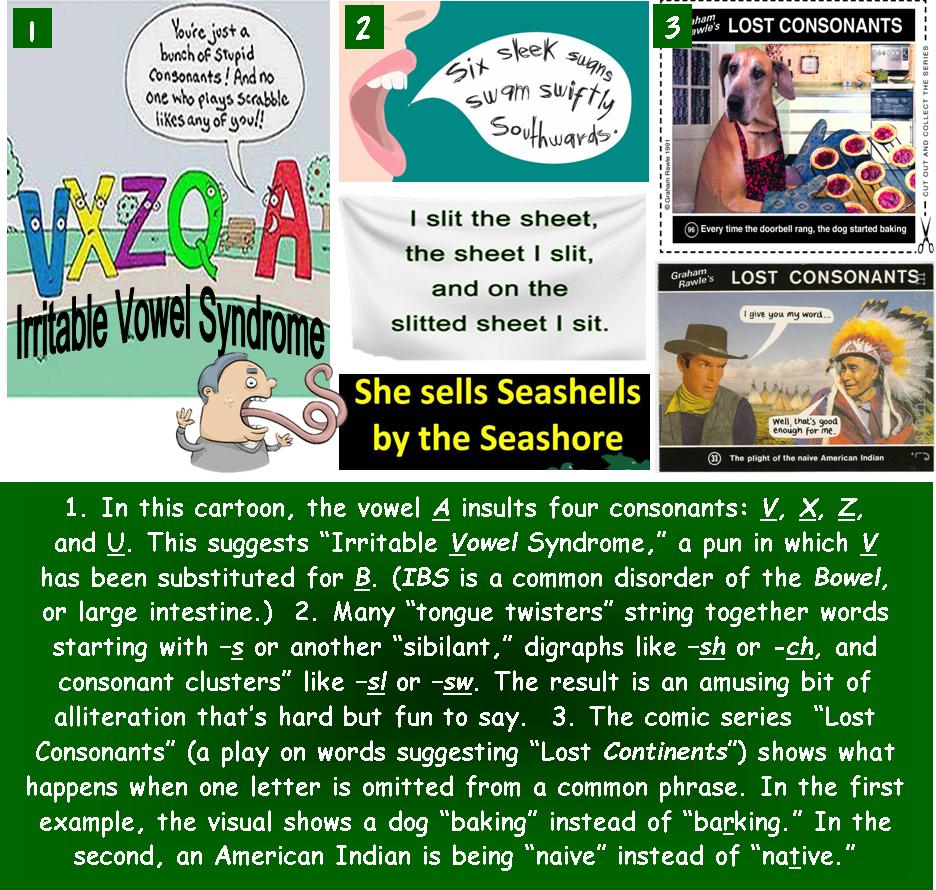How to Teach (Yourself) How to Pronounce 24 American-English Consonant Sounds
So what’s funny about consonants? There’s a plethora of tongue twisters, puns, letter omissions, word substitutions, and other humor that will evoke at least a chuckle. Do you get the joke of these six items? (Feeble attempts at explanation follow.)

Instead of the “speech music” of syllable-stress patterns and rhythm, basic instruction in clear, comprehensible speech may begin with sounds—isolated, in contrast, and in context. Before, along with, or after instruction in Vowel Sounds & Spellings, it’s important to know how to pronounce, read aloud, spell, and clearly pronounce consonant sounds—in initial, medial, and final word positions.
So what’s fundamental to know about the American-English system of consonant sounds and spellings?
- 24 Consonant Sounds: To pronounce most of the 24 consonant sounds of English, parts of the mouth touch or almost touch. Unlike for vowel sounds, there’s no free passage of air for consonants. Although vowel sounds define syllables, consonants begin many of them.
As illustrated in the article Clear Speaking: Value Versions of Vowels, there are at least 16 “Places in the Mouth” where American-English vowel sounds are articulated. Perhaps coincidentally, there are also 16 distinguishable ways to pronounce consonants, of which there are 24 in the language. (Eight of the sounds are pronounced just like eight others, except that only one sound of each pair involves the vocal cords). These 16 “pronunciation techniques” differ from one another in [1] where they’re said in the mouth (in the front, middle, or back), [2] how the lips are shaped (open or closed, rounded or flat), and [3] which mouth parts (the lips, teeth, tooth ridge, hard or soft palate, tongue) touch or almost touch.
Can you pronounce Consonant Sounds 1-24 and the words they begin that are shown this Diagram of the Mouth?
- 8 Consonant Sounds x 2 = 16 Pairs + 8 Other Sounds. Sixteen consonants occur in pairs. Eight others don’t. The two sounds of each pairing / b—p, d—t, g—k, v—f, th—th, z—s, zh—sh, j—ch / are said the same—except that one is “voiced” (pronounced with vibration of the vocal cords), and the other is “voiceless” (not said “with voice” or vocalized). Except for / h /, the other English consonant sounds / m—n—ng, r—l, w—y / are all voiced. Only one of these sounds, (/ ng /) doesn’t occur in initial word position.
- Initial Consonant Clusters. A word or syllable can begin with a sequence of two or three consonants called a consonant “cluster” or “blend.” There are no vowel sounds between any of the sounds. For help and fun in pronouncing and spelling 22 of the most common of these blends, take a look at Pronunciation: Part Three-7: Initial Consonant Clusters, from Beginners’ Before Speaking with Pronunciation Principles.


- Medial & Final Consonants. All 24 single and combined consonant sounds of American English can come in the middle of words. And most consonants can also end a syllable or word—as can most consonant clusters or blends. Many of the oral and written patterns and rules that apply to initial consonants pertain to medial & final consonants as well—but not all of them. To better your own and others’ pronunciation and spelling of consonant sounds, explore the differences. For all you need to get started, here are pages from Pronunciation: Part Three-8: Medial & Final Consonants, Beginners’ Before Speaking with Pronunciation Principles. And for even more tips and info, refer to the “Challenge Activities” that appear in the full chapters of this text.
- Consonant Contrasts. Whether you’re targeting the sounds and spellings of initial, medial, or final consonants, it may help to compare their features. For instance, voiced sounds can be contrasted with their voiceless counterparts. The “stops” / b p d t g k /—for which the air is blocked and then released—can be practiced along in contrast to the “continuants” / v f z th dz sh s /, which are articulated with friction. Consonant clusters can be compared to single and combined sounds. And all consonant sounds and spellings can be analyzed according to where they occur in words.

- Play Consonant-Sound Bingo. How can Phonics & Spelling Bingo games that feature consonants in minimal pairs & groups be especially productive in pronunciation practice? Instead of having a Caller shout out items, players themselves can articulate words that contrast sounds in initial, medial, and final positions. The reactions of their listeners will serve as natural feedback, impelling learners to improve the clarity of their speech. Why not try out this technique with materials like Sample Games 21-24, 29, 31-32: Contrasts in Initial, Medial, & Final Consonant Sounds (+ Silent Consonants) from Intermediate- & Advanced Phonics & Spelling Bingo Activity & Idea Books? To maximize their use, you can follow instructions in the resource books themselves and/or make up your own procedures and rules for creative, effective lessons and games.
- Use Four-of-a-Kind Initial-Consonants Cards in preparation, lesson, game, follow-up, and testing activities. How can you continue to improve your and others’ clear pronunciation of consonants while having a good time and increasing vocabulary? You can play cards! Teach/learn, engage, and otherwise enjoy illustrated card packs that match initial consonant sounds and clusters in sets-of-four words (for Actions/Activities, Animals/People, Places, and Things). Here’s the first half of a pack of Initial-Consonants Cards, Intermediate Level (80 Words with Common Spellings for 20 Consonants Sounds & Clusters) to download, cut apart, and integrate into instruction and practice. For ideas on how to maximize and go beyond their use, see the accompanying Activity & Idea Book. Or—as usual—devise even more instructive lessons and activities of your own.
- Do vocabulary puzzles that focus on consonant sounds and spellings, like those in Intermediate Phonics & Spelling Puzzles for Word-Level Pronunciation, Reading, & Vocabulary Learning: Consonant Sounds & Letters. Summarizing pedagogy begins the 18-page section. Then come 4 pages targeting Initial Consonants, 4 for Final Consonants, and 4 for Consonant Combinations. In addition to word searches and crosswords, there are many other creative formats that motivate language learners and new readers to add, subtract, move, and otherwise manipulate letters to get answers. After an illustrated Answer Key and a Reference Word List, there’s even a Consonant Path-Game Board.
The full chapters of the excerpts gifted above are taken from several Authors & Editors products:













